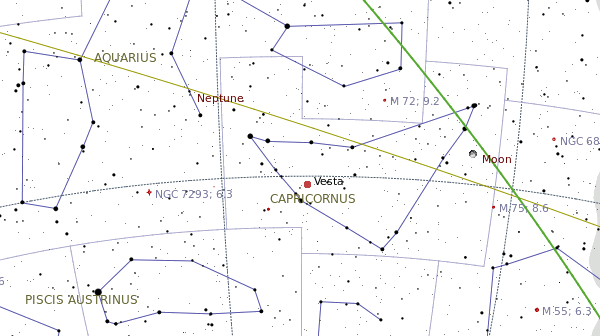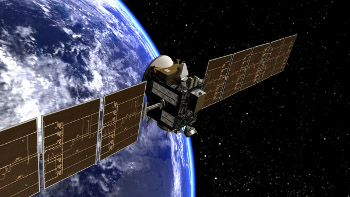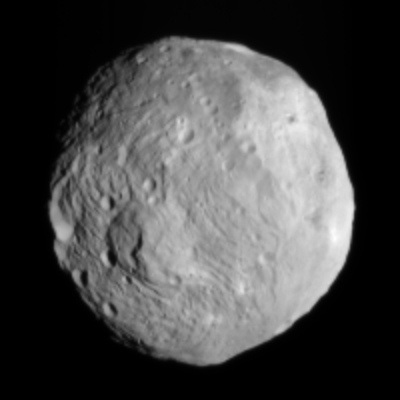Vesta
July 18, 2011
The
Roman pantheon of gods and goddesses was huge. That's probably one reason why
astronomers continued to tap into that name pool beyond the names of the classical
planets,
Mercury,
Venus,
Mars,
Jupiter and
Saturn. Even the
River Nymphs were called into service, for the naming of
Naiad, the innermost
satellite of
Neptune.
Vesta was the Roman goddess of hearth and home. She is identified with the
Greek goddess
Hestia. The
Vestal Virgins were the priestess order of Vesta, and they were charged with keeping her sacred fire ever burning. The concept of an
eternal flame exists even today.
Vesta is the name of a rather large
asteroid in the
asteroid belt between the orbits of Mars and Jupiter. Second only in mass to the asteroid (or is it
dwarf planet? It's hard to keep track, nowadays.),
Ceres, it contains about nine percent of the total mass of the asteroid belt, and it's about 500
kilometers in diameter. About five percent of
meteorites falling to
Earth originate from Vesta.[1]

Location of Vesta in mid-July, 2011, via Kstars
There have been so many
spacecraft launched, both manned and unmanned, that it's easy to forget how difficult such a task is, and how excited we were in the 1950s and 1960s when we were taking our first steps into the
final frontier. As a child, I kept a
scrap book of newspaper and magazine articles about
rockets and spacecraft. In those days, every launch was front-page news, and the popular weekly magazines, such as
Life, regularly published lengthy articles about our future in space. The
Disney enterprise devoted many of their Sunday broadcasts to space tutorials.
NASA is attempting to revive interest in its spacecraft by calling for a celebration of a
Vesta Fiesta to celebrate the arrival of the
Dawn spacecraft at Vesta.[1-8] In my area, the
United Astronomy Clubs of New Jersey has scheduled its Vesta Fiesta for August 5-7, 2011.

An artist's rendition of the Dawn spacecraft leaving Earth on its way to Vesta.
NASA/JPL-Caltech/UCLA/McREL Image)
The Dawn spacecraft is remarkable for having huge
solar panels that are a total of sixteen
meters in length. It's the largest interplanetary spacecraft ever launched by NASA. All that
photovoltaic energy is needed to power Dawn's three
ion thruster engines. These ion engines have very low thrust, but they are very efficient. In terms most
automotive buffs will understand, Dawn's "zero to sixty" using ion thrust is about four days. The ion engines, however, can operate continually, piling on the
acceleration.[4]
Dawn is NASA's first spacecraft with ion propulsion. Ion propulsion is highly efficient, since it provides an order of magnitude greater thrust per weight of fuel than
chemical propellants. The source of the
ions is an onboard supply of 425 kilograms of
xenon. Xenon is used, since it's a
cryogen that liquefies at 165 K, and it's a heavy ion with
atomic weight about 131.[6]
Dawn's journey to Vesta was 1.7 billion
miles, requiring two
orbits around the
Sun over the course of almost four years. As it arrives at Vesta, its distance from Earth is about 117 million miles (188 million kilometers).[1] It will spend a year in orbit about Vesta, studying
mineral composition and surface features. Dawn will then travel 96,000 miles to Ceres, where it should orbit in February 2015.
Vesta and Ceres are quite different from each other. Vesta has a
density (3.42 g/cc) that's quite close to that of
basalt, and it has an
iron core. This makes it very similar to the other
terrestrial planets, Earth, Mars and Mercury. Vesta is a
protoplanet; namely, a planetary body that just didn't reach the size of the other terrestrial planets. Ceres, which is about 950 kilometers in diameter, is low density (2.08 g/cc), and it likely contains
water ice and a rocky core.[6]

An image of the asteroid, Vesta, obtained on July 9, 2011, by the Dawn spacecraft.
Vesta was 41,000 km distant (26,000 miles) at the time, and the image resolution is about two-and-a-half miles.
NASA/JPL-Caltech/UCLA/MPS/DLR/IDA Image)
Dawn will be in an initial orbits of about 9,900 miles (16,000 kilometers), but there are plans to approach to within 200 kilometers.[1] The first color images should be acquired almost immediately. At the closest planned approach, the image resolution will be twenty meters per
pixel.[2]
Today, July 18, 2011, is
John Glenn's ninetieth birthday. Glenn was the first American to orbit the Earth, on February 20, 1962. This was a bit behind
Yuri Gagarin, who was the first human in outer space, and the first to orbit the Earth, on April 12, 1961. Thus started the
space race. Happy birthday, John!
References:
- Jonathan Amos, "Dawn probe set to orbit Asteroid Vesta," BBC News, July 14, 2011
- Jonathan Amos, "Asteroid Vesta comes into focus," BBC News, July 13, 2011
- Jia-Rui Cook and Priscilla Vega, "NASA Spacecraft to Enter Asteroid's Orbit on July 15," JPL Press Release, July 14, 2011.
- Suzanne Presto, "US Spacecraft to Rendezvous with Asteroid," Voice of America, July 14, 2011.
- Brian Vastag, "Destination asteroid: NASA probe arrives at ancient 'mini moon'," Washington Post, July 15, 2011.
- Alok Jha, "Dawn spacecraft keeps her date with asteroid Vesta 117m miles away," Guardian (UK), July 15, 2011
- Jonathan Amos, "Dawn probe orbits asteroid Vesta," BBC News, July 17, 2011.
- Dawn site at JPL.
Permanent Link to this article
Linked Keywords: Roman; pantheon; astronomer; planet; Mercury; Venus; Mars; Jupiter; Saturn; Naiads; River Nymphs; satellite; Neptune; Vesta; Greek; Hestia; Vestal Virgins; eternal flame; 4 Vesta; Vesta; asteroid; asteroid belt; dwarf planet; Ceres; kilometer; meteorite; Earth; Kstars; spacecraft; Where no man has gone before; final frontier; scrap book; rocket; Life; Disney; NASA; Vesta Fiesta; Dawn; United Astronomy Clubs of New Jersey; solar panel; meter; photovoltaic; ion thruster engine; automotive; acceleration; chemical propellant; ion; xenon; cryogen; atomic weight; mile; orbit; Sun; mineral; density; basalt; iron; terrestrial planet; protoplanet; water ice; pixel; John Glenn; Yuri Gagarin; space race.